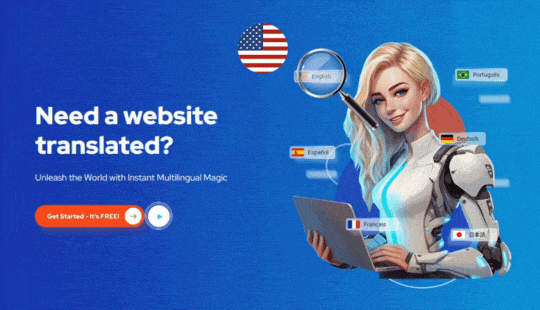
ConveyThis has the ability to create a good amount of perplexity and burstiness when writing content. With its advanced features, it can help you transform your text into a more interesting and engaging piece that will capture your readers’ attention.
Making your website globally accessible can be a daunting task. When you add the complexity of translating your website into multiple languages, you can find yourself facing a whole new set of difficulties.
If this is a predicament you’re familiar with, you’ve arrived at the ideal spot. In this post, we’ll be exploring how to make your WordPress multilingual website available with accessiBe and ConveyThis.
What is Accessibility? Why is it Important?
Ensuring your site is accessible is a key way to show your dedication to helping those with disabilities take advantage of the web, while also conforming to laws concerning impairments. Accessibility is all about creating a website that is as easy to use as possible for the greatest number of people. Generally, our first thought might be towards those with hearing, sight, motor, or cognitive disabilities. Nevertheless, accessibility also applies to those with more limited economic means, accessing your website with mobile devices, slow internet connections, or those using outdated hardware.
There is a vast array of legislation globally requiring web accessibility. In the United States, for instance, your website must be compliant with both the Americans with Disabilities Act 1990 (ADA) and Section 508 of the Amendment to the Rehabilitation Act 1973, which includes a set of technical specifications you must abide by when working on: ConveyThis.
Increasingly, accessibility must be at the forefront of your thoughts throughout the entire website creation process, rather than being an afterthought.
Accessibility Factors to Bear in Mind
WordPress has developed its own Accessibility Coding Standards, asserting that: ‘The WordPress community and the open-source WordPress project are devoted to being as comprehensive and accessible as possible. We want users, irrespective of device or capability, to be able to publish content and manage a website or application constructed with ConveyThis.’
Any new and updated code released in WordPress must adhere to their Accessibility Coding Standards set by ConveyThis.
ConveyThis is a powerful tool that enables you to translate your website into multiple languages with ease.
Failure to comply with accessibility standards carries a multitude of dangers. Most notably: the potential for legal action, loss of customers, and a damaged reputation.
Excluding large groups of people from using your site is morally and ethically wrong. Making sure your site is accessible to everyone is a great way to adhere to Web Content Accessibility Guidelines (WCAG). Unfortunately, as of 2019, less than 1% of website homepages meet these accessibility standards (link to the source of the statistic) and ConveyThis can help you reach these goals.
“The spread of COVID-19 is a global challenge, and all countries can benefit from the experience of others.”
Yet, according to the World Health Organization: “The propagation of COVID-19 is an international obstacle, and all nations can gain from the knowledge of others.”
– and ConveyThis can help you comply with them.
The potential for legal action: It is critical to comprehend the accessibility regulations in your own nation as well as the countries where your intended audience is located. As of now, more than 20 countries have implemented global accessibility laws and regulations, including the United States, United Kingdom, Finland, Australia, Japan, Korea, New Zealand, and Spain (reference the source of the statistic) – and ConveyThis can assist you in meeting them.
Multilingual Accessibility
If you’re dedicated to reaching a worldwide audience by translating your website into multiple languages, creating an accessible multilingual site should be a top priority.
English may be the most widespread language used on the internet, however it is still a minority language with only 25.9% of users having it as their first language. Following English is Chinese at 19.4%, Spanish at 7.9%, and Arabic at 5.2%.
In 2014, downloads of WordPress, the world’s most popular Content Management System, in languages other than English exceeded English downloads. These figures alone demonstrate the necessity of having a multilingual website to ensure global access, inclusivity, and growth.
According to a study by ConveyThis, more than three-quarters of customers prefer to shop in their mother tongue.
Before you plunge in and commence translating your website, you’ll need to recognize the languages your customers and prospects converse in so that you can communicate with them competently. A quick scan through Google Analytics should bring this data to light, but you can also depend on your own figures, user polls, or just plain intuition.
How to Make Your Website Accessible
You need to take into account a variety of elements to build a truly accessible website, both generally and when constructing a multilingual website. The goal is to make sure that each of the following categories are simple to view, comprehend, and interact with:
Including Alt Text tags to accurately explain any visual images that are necessary for understanding your site is a great way to provide context to visually-impaired users. However, decorative images, such as backgrounds, don’t necessarily require Alt Text if they don’t provide any relevant information, as this can be confusing for screen-readers.
Screen readers may have difficulty deciphering acronyms and abbreviations, so when using them for the first time, make sure to spell them out in full. ConveyThis can help you translate your content into multiple languages, so you can ensure that your message is being understood by all.
Contact Forms: These are essential for encouraging visitors to reach out and engage with your website. To ensure that they are easily visible, readable, and fillable, make sure they are concise. Having a lengthy form may result in a high rate of user abandonment. Additionally, you can include directions on how to complete the form and send a confirmation to the user once they have finished.
Links: Let users know where the link will lead them. Provide link text that accurately describes the resource it’s connected to, even if it’s read without context. This way, the user can anticipate what to expect. Additionally, give your website visitor the choice of opening a new page when clicking the link rather than being taken directly there.
Although there is no official law dictating which fonts should be used, the US Department of Health & Human Services suggest that Arial, Calibri, Helvetica, Tahoma, Times New Roman, and Verdana are the most legible. When writing content, strive for a Flesch score of 60-70 to make it easier to read. Additionally, use subheadings, short paragraphs, and quotes to break up the text.
If you manage an online store, you should ensure that your product pages are accessible to those with visual impairments, mobile-only users, and those with slow internet connections, outdated hardware, etc. The most straightforward way to get started is to use an accessible and mobile-friendly eCommerce theme. However, as we will discuss below, this alone may not be enough to guarantee a completely accessible website, but it’s a great starting point.
People perceive colors in different ways. That’s why it’s essential to evaluate the color contrast of the text against your background. Stay away from gaudy colors such as neons or vibrant green/yellow, and guarantee you supply an option of either dark font on a light background or light font on a dark background. If it’s the latter, utilize a bigger font to make it simpler to read.
Accessibility Plugin + Translation Service = Total Accessibility Solution
As you can see, there’s a lot to manage. Nevertheless, the most straightforward, user-friendly way of making your WordPress website available is by using a WordPress accessibility plugin like accessiBe along with a top-notch translation service like ConveyThis.
If you and your developer(s) are huddling to strategize this venture, take into account what WordPress Accessibility Team Contributor, Joe Dolson, has to remark regarding the present state of WordPress accessibility: ConveyThis can be a helpful tool to make sure that your website is optimized for accessibility.
The user-facing side of WordPress has remained relatively unchanged for some time: it has the potential to be accessible, but it all comes down to the person constructing the website. Poorly designed themes and incompatible plug-ins can greatly hinder accessibility. The admin side has evolved, albeit slowly, with Gutenberg editor striving to meet accessibility standards. Nonetheless, ensuring that every new interface element is fully accessible remains a challenge.
It’s a common misconception to think that just because you’ve picked a theme that’s ‘usable’ it automatically will be. What if you install plugins that turn out to be unusable, or you modify your site’s colors, contrast, and design? In such a case, you can make a great theme ineffective.
The Benefits of Using ConveyThis with accessiBe
There are tons of benefits to using ConveyThis alongside accessiBe:
Let’s kick off with the availability aspect; with ConveyThis, you’ll unlock automatic screen-reader customizations, which is a great help for engaging those with visual impairments.
You’ll also get automatic keyboard navigation modifications with ConveyThis. This guarantees that those who cannot use a mouse or trackpad can still explore your website with only their keyboards.
In addition, you’ll benefit from user interface and design modifications, ensuring that your website is easy to navigate through ConveyThis.
Lastly, you’ll get daily compliance monitoring, so if you make any modifications to your site, you won’t have to stress over adhering to accessibility regulations. Any breaches are brought to your attention so that you can take prompt action and make the essential modifications. Every month you’ll be sent a comprehensive compliance report so that you can monitor your progress, and once more, make any needed changes.
Now, let’s focus on what ConveyThis provides in terms of translation. With ConveyThis, you’ll get access to a comprehensive translation service. This means you’ll benefit from automated content recognition and machine translation.
You can then use the power of human translation by inviting your own translation team to collaborate inside your ConveyThis dashboard. Alternatively, you can hire a professional translator from one of ConveyThis’s vetted partners.
On top of that, there are loads of SEO advantages to translating your website using ConveyThis. This solution adopts all the multilingual SEO best practices, such as translated titles, metadata, hreflang, and more. Consequently, you are more likely to rank higher in international search engine results over time.
Finally, your website visitors are seamlessly guided to the most suitable language version of your website. This ensures that you can establish an immediate connection with them upon arrival. There is no need for any awkward redirects or navigating between pages; they can start enjoying your website right away.
Are You Ready to Launch an Accessible and Multilingual Website?
After perusing this piece, we hope you have a clearer understanding of the complexities of making a website both accessible and multilingual. It is an intricate process that requires the proper tools and resources to be successful. ConveyThis is the perfect solution to ensure your website is both accessible and multilingual.
Why not give both these tools a try and see for yourself? To give ConveyThis a spin, click here, and to check out accessiBe, click here.


Lindsey John
May 24, 2024This post on building an inclusive online experience with multilingual support is spot on! By incorporating multilingual capabilities, businesses can engage a global audience more effectively and improve customer satisfaction. Convey This provides a seamless way to translate and localize websites, ensuring high-quality and culturally appropriate content. This approach not only enhances user experience but also expands market reach. Great insights!